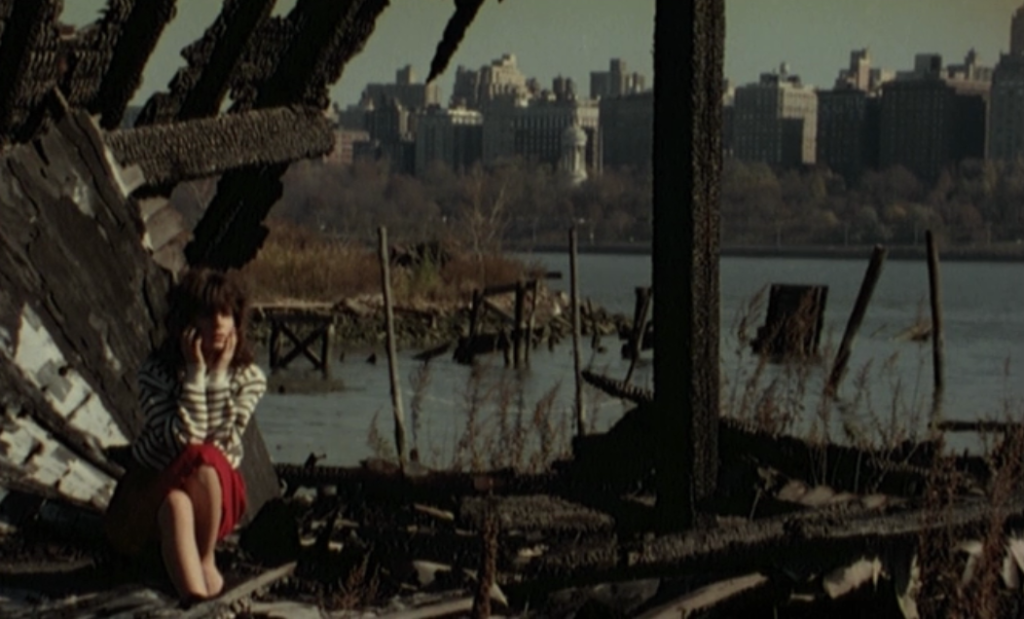
Two little girls happen upon each other in the rural countryside of France and decide to play together. They steal away into the attic of an abandoned farm house with the statue of the Moon Goddess in hand. Hidden away from the world the two girls pour through adventure books and travel magazines. Each girl imagines herself as part of the story, together forming a collective imagination of two. Through the power of the Moon Goddess their imaginations transport them to New York City. In New York they are each twenty-three years old. Lost in New York the two girls must find one another and return home, having a myriad of adventures along the way.
Filmmaker Jean Rollin shot Perdues dans New York (1989) for French television on location in a pre-Giuliani New York City. Rollin explores the city with his post-Gothic style, recording the urban spaces with an expressionistic camera. As Rollin follows his protagonists he locates where Gothic and folkloric traditions intersect and become manifest within his images of urban decay. Perdues dans New York is the pinnacle of Rollin’s style, the lynchpin that connects all of his cinematographic texts. At the heart of Perdues dans New York is the notion that the movie screen is a screen of dreams.
Each girl takes elements of the adventure stories and travel magazines and makes them her own. Yet, together as a pair they form a collective language of images and gestures that each individually understands. The act of imagining in Perdues dans New York is the act of cinema. For every spectator the cinema has its meaning that, within the context of society, shapes our collective understanding of the medium. Just as the two girls weave in and out of crime stories, vampiric encounters, fantasy adventures, etc. so does the cinema encompass all experience.
Perdues dans New York is the cinema fantastique in microcosm. With the dawn comes the end of one fantasy and the beginning of another. Rollin takes this central motif of his vampire films and transforms it into an allegory for cinematographic spectatorship. Perdues dans New York is brimming with cinematographic gestures that function on two levels. On one level these devices propel the action of the film while on another level they suggest the very modus operandi of the cinema as a shared dreamscape.
Like so many of Rollin’s films Perdues dans New York is saturated with the pale browns and ambers of autumn. There’s an eerie uncanniness to Perdues dans New York that is both visual and performative. Despite its metropolitan setting, Perdues dans New York belongs to the world of Rollin’s Gothic Horror films. Early on in Perdues dans New York Rollin, in a voice over during a montage of storybook illustrations, lists those films whose similar stylization suggest the same collective imagination and shared dreaming as Perdues dans New York. From Duel In The Sun (1946) to Zéro de conduite (1933), Rollin locates the power of the Moon Goddess to immerse the dreamer/spectator in a fantasy world that merely suggests our own.
Within this intertextual complex nothing is real in the traditional sense, only representative in the most abstract sense. Perdues dans New York closes in on the central concept of Jacques Rivette’s Céline et Julie vont en bateau (1974) and reveals it in close-up. Where Rivette couched this notion of the cinema as collective imagining in humanism, Rollin distills it into pure fantasy. Despite these different approaches, both directors celebrate the cinema as a social mechanism; a way to render the vastness of the human imagination as something tangible and communicable. For both Rollin and Rivette this power that the cinema has is magical. Their wonder and awe is such that the only form that the only way they can articulate their thoughts is in the context of magic and sorcery.
It’s also worth noting that Céline et Julie vont en bateau and Perdues dans New York are films about female friendships. Politically speaking, the cinema is a maternal rather than a paternal device for these two filmmakers. This is even more true for Rollin whose genre specific cinema has always dealt with female superiority in the form of witches, vampires, and blood cults. The women in Rollin’s films are always gifted with a supernatural ability of some sort that in Perdues dans New York happens to be imagination itself.
